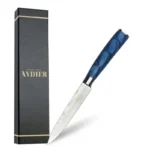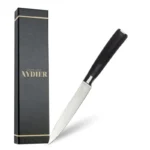Utility Knives

Utility Knife: A Versatile Essential in the Kitchen
A utility knife is one of the most practical tools in any kitchen, bridging the gap between a large chef’s knife and a small paring knife. With a blade typically ranging from 4 to 7 inches, it offers just the right size and control for everyday food preparation. Many cooks describe it as their “go-to knife” for quick tasks that don’t require the power of a chef’s knife but need more reach than a paring knife can provide.
Everyday Uses of a Utility Knife
The strength of the utility knife lies in its versatility. It is slim enough to handle delicate jobs like slicing fruit, trimming herbs, or cutting cheese, yet sturdy enough to work through sandwiches, small cuts of meat, or vegetables with tougher skins. For those who prepare quick meals at home, the utility knife often becomes the blade that is used most often throughout the week.
How It Differs from Other Japanese Knives
Compared to larger Japanese knives such as the Santoku knife or Gyuto (chef’s knife), the utility knife offers greater precision and lighter handling. A Santoku, for instance, excels at chopping and dicing larger ingredients thanks to its wider blade, while a utility knife shines when you need accuracy on smaller items. Many professional chefs keep both at hand, switching between them depending on the task.
Choosing the Right Size and Steel
Utility knives are commonly found in 5 or 6 inch versions, which provide a good balance between reach and control. Smaller blades lean toward finer detail work, while longer ones are more useful for portioning or slicing. The choice of steel also makes a difference. High-carbon steel delivers excellent sharpness and edge retention, while stainless steel offers durability and easier care. For those who appreciate traditional craftsmanship, Damascus steel utility knives combine performance with distinctive layered patterns.
Care and Maintenance for Long-Lasting Performance
Like all quality kitchen knives, a utility knife performs best when properly maintained. Regular honing helps keep the edge aligned, while periodic sharpening with a whetstone ensures lasting precision. Hand washing and careful storage, whether in a wooden block, sheath, or on a magnetic strip, protects the blade and keeps it ready for daily use.
Why Every Cook Needs One
While some knives are highly specialized, the utility knife adapts easily to a wide range of tasks. Whether you are preparing vegetables for a quick stir-fry, slicing cured meats for a sandwich, or trimming citrus for a garnish, this knife provides the versatility and control that make cooking more efficient. For beginners and experienced chefs alike, it remains an indispensable part of the kitchen toolkit.

